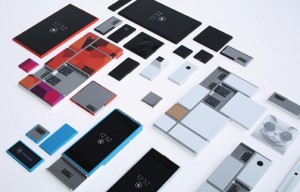Tech column: Build your own device
Mobile customization at a whole new level
BAJ Visser
Tech Columnist
The BYOD, or Bring Your Own Device, movement flipped the mobile business on its head in 2009.
No longer were employees forced to use company-issued phones. Instead, they could use their favourite iPhone or Android device as their company phone.
Sure, there were concerns about privacy, as well as casualties along the way (R.I.P. Blackberry), but those were usually acceptable sacrifices to greater employee freedom.

Build your phone like Lego - have a chance to put the blocks together to create a phone that perfectly suits your needs. Photo courtesy: Motorola Blog
This trend has recently even expanded to laptops, tablets and other devices you might use on the job — allowing you to use your favourite gadgets and brands at home and work.
However, even with this freedom, we’re still somewhat limited. The phone manufacturers determine what our phones will be like, from the camera to the screen, the processor to the operating system running inside. The same can be said about tablets, streaming devices and even game consoles. But wouldn’t it be great if you could make those choices yourself?
This idea seems less farfetched now. Google’s Project Ara, ZTE’s Eco-Mobius and Valve-supported Steam Machines have all revealed early prototypes and betas over the past few months. Could this be the start of a new BYOD trend — Build Your Own Device?
Google’s Project Ara is probably the most notable, having arisen from Phonebloks, a modular phone concept created by Dutch designer Dave Hakkens. His idea was sparked by the amount of electronic waste created by our current phone lifecycle: a year or two and your brand new smartphone is likely destined for the dump and with it the valuable metals used to make its circuit board.
Hakken’s idea is simple: make phones like Lego, with new “bloks” you can plug in if anything breaks, or you want an upgrade, or even if you’d, say, prefer a larger battery over a better camera lens. This is the freedom that PC aficionados have had since the early days of the personal computer, so it’s high time the miniature computers most of us carry throughout the day have the same flexibility.
Hakeen is now working with Google on their Android-based Phonebloks derivative known as Project Ara. It’s still in the early stages, but Google has announced they expect the basic framework to cost about $50 when it finally does become available to the public. Of course, that’s just the basic framework. Upgrading it will likely cost a pretty penny. For the economically minded among us (not to mention the ecologically-minded), the prospect of phones being available for less than a monthly phone bill is appealing.
Of course, I would be remiss if I didn’t note another interesting Build Your Own Device project, well on it’s way, to actualization. Valve, the creators of classic video games such as Half Life, Portal, and Left 4 Dead, as well as Steam, the popular video game distribution platform, have decided to enter the console and home entertainment market.
They are seizing the opportunity provided by the rather lack-luster launches of Sony’s Playstation 4 and Microsoft’s Xbox One (the less said about Nintendo’s Wii U, the better). Valve has announced Steam OS, a Linux-based operating system designed specifically for gaming and streaming videos and music from the web. Steam OS can run either on speciality gaming PCs known as Steam Machines, or installed on existing PCs to turn them into gaming consoles with all your favourite Steam games available.
Of course, neither Steam Machines nor Project Ara are available for the masses quite yet and we don’t know if they’ll be revolutionary successes or massive flops not seen since, Windows 8. However, they, along with other projects like them, point to a future of more customization, flexibility and consumer freedom. A future where you can build your own device, that’s a beautiful thing.



